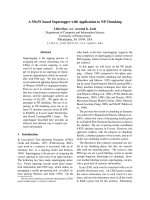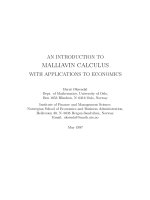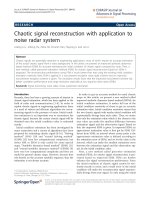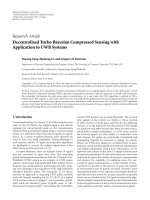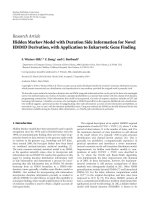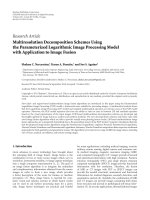Energy security indexes a survey with application to singapore
Bạn đang xem bản rút gọn của tài liệu. Xem và tải ngay bản đầy đủ của tài liệu tại đây (1.41 MB, 125 trang )
ENERGY SECURITY INDEXES:
A SURVEY WITH APPLICATION TO SINGAPORE
CHOONG WEI LIANG, DESMOND
NATIONAL UNIVERSITY OF SINGAPORE
2014
ENERGY SECURITY INDEXES:
A SURVEY WITH APPLICATION TO SINGAPORE
CHOONG WEI LIANG, DESMOND
(B. Eng. (Hons.), NUS)
A THESIS SUBMITTED
FOR THE DEGREE OF MASTER OF ENGINEERING
DEPARTMENT OF INDUSTRIAL AND SYSTEMS
ENGINEERING
NATIONAL UNIVERSITY OF SINGAPORE
2014
Acknowledgements
Acknowledgements
I would like to express my sincere gratitude to Prof Ang Beng Wah, my research
supervisor for his guidance throughout this research project. Without his advice and
expertise, this research will not have been a success.
I would also like to thank my co-supervisor A/P Ng Tsan Sheng, Adam, and Dr. Su
Bin (Energy Studies Institute) for their kind advice and encouragement throughout
the development of this research. Their insightful comments have helped to make this
work better in many ways.
Special thanks also go out to all other faculty and staff members in the Department of
Industrial and Systems Engineering for making my stay enjoyable and comfortable.
Their suggestions and comments have helped in one way or another during this time.
Lastly, I would like to thank my family for the encouragement and unwavering
support given to me throughout my journey in life.
iv
Table of Contents
Table of Contents
Acknowledgements ...................................................................................................................iv
Table of Contents ....................................................................................................................... v
List of Figures ..........................................................................................................................vii
List of Tables.............................................................................................................................ix
List of Abbreviations and Acronyms ......................................................................................... x
Summary ..................................................................................................................................xii
Chapter 1.
Introduction .......................................................................................................... 1
1.1 Energy Security and energy security indexes .................................................................. 1
1.2 Motivation ........................................................................................................................ 1
1.3 Thesis structure and contribution ..................................................................................... 2
Chapter 2.
Literature Review of Energy Security Indexes ..................................................... 4
2.1 Introduction ...................................................................................................................... 4
2.2 Review of past studies...................................................................................................... 5
2.3 Definitions and trends ...................................................................................................... 7
2.4 Changing emphasis over time ........................................................................................ 10
2.5 Other observed features ................................................................................................. 12
2.6 Energy Security Indices and trends ................................................................................ 13
2.7 Number of indicators ..................................................................................................... 15
2.8 Temporal versus spatial studies ..................................................................................... 16
2.9 Specific focused areas in index construction ................................................................. 16
2.10 Energy security index construction .............................................................................. 20
2.11 Conclusion ................................................................................................................... 24
Chapter 3.
Singapore Energy Security Index (SESI) Framework Design ............................ 27
3.1 Introduction .................................................................................................................... 27
3.2 Other existing frameworks ............................................................................................. 28
3.3 SESI framework ............................................................................................................. 30
3.4 Selection of Indicators ................................................................................................... 31
3.5 Banding of indicators ..................................................................................................... 32
3.6 Weighting and aggregation ............................................................................................ 36
3.7 Evaluation of SESI methodology ................................................................................... 36
3.8 Conclusion ..................................................................................................................... 40
v
Table of Contents
Chapter 4.
Implementation of SESI ..................................................................................... 41
4.1 Introduction .................................................................................................................... 41
4.2 Data sources ................................................................................................................... 41
4.3 Singapore energy security indicators ............................................................................. 41
4.4 Normalization ................................................................................................................ 48
4.5 Weighting and aggregation ............................................................................................ 49
4.6 Discussion of results ...................................................................................................... 50
4.7 Recommendations .......................................................................................................... 56
4.8 Conclusion ..................................................................................................................... 57
Chapter 5.
Scenario and sensitivity analysis ........................................................................ 59
5.1 Introduction .................................................................................................................... 59
5.2 Scenarios and assumptions............................................................................................. 59
5.3 SESI indicators (2010 - 2035) ........................................................................................ 63
5.4 Results ............................................................................................................................ 68
5.5 Sensitivity analysis......................................................................................................... 70
5.6 Conclusions .................................................................................................................... 71
Chapter 6.
Conclusions ........................................................................................................ 75
6.1 Concluding remarks ....................................................................................................... 75
6.2 Limitations of proposed framework and index .............................................................. 76
6.3 Future research topics .................................................................................................... 77
References ................................................................................................................................ 79
Appendix A.
Energy security studies reviewed ................................................................... 86
Appendix B.
Energy security studies with indicators or indexes ........................................ 91
Appendix C.
The Energy Trilemma and Singapore's energy profile .................................. 96
Appendix D.
Scenario projections for SESI ...................................................................... 107
Appendix E.
Banding results for projections .................................................................... 110
vi
List of Figures
List of Figures
Figure 2.1 Distribution of energy security studies by publication type for different
time periods................................................................................................................... 6
Figure 2.2 Number of energy security studies by country/region................................. 7
Figure 2.3 Coverage of each energy security theme in energy security definition by
time period. ................................................................................................................. 11
Figure 2.4 Coverage of each energy security theme in energy security definition by
publication type........................................................................................................... 12
Figure 2.5 Coverage of each energy security theme in energy security definition for
quantitative and qualitative energy security studies. .................................................. 13
Figure 2.6 Distribution of the number of indicators for 51 energy security studies ... 15
Figure 2.7 Number of studies focusing on each SFA in energy security index
development ................................................................................................................ 19
Figure 2.8 Normalisation, weighting and aggregation methods in energy security
index construction. ...................................................................................................... 20
Figure 2.9 Distribution of normalisation methods in energy security index
construction ................................................................................................................. 22
Figure 2.10 Distribution of weight assignment methods in energy security index
construction ................................................................................................................. 23
Figure 3.1 SESI Framework ....................................................................................... 30
Figure 4.1 SESI framework with weights ................................................................... 50
Figure 4.2 Singapore Energy Security Index (SESI). ................................................. 51
Figure 4.3 Graph of energy supply chain sub-index results (1990 – 2010). ............... 52
Figure 5.1 Economic sub-index projections ............................................................... 68
Figure 5.2 Energy system sub-index projections ........................................................ 69
Figure 5.3 Environmental sub-index projections ........................................................ 70
Figure 5.4 SESI projections ........................................................................................ 72
vii
List of Figures
Figure 5.5 SESI and Energy Supply Chain Sub-index: Equal weight case versus the
reference case. ............................................................................................................. 74
Figure C.1 The energy trilemma ................................................................................. 96
Figure C.2 Influence diagram for energy policies ...................................................... 98
viii
List of Table
List of Tables
Table 2.1 Normalisation versus weighting methods. .................................................. 24
Table 3.1 Comparison of existing frameworks for measuring energy security .......... 29
Table 3.2 Criteria ratings for indicators ...................................................................... 33
Table 3.3 Criteria rating results for indicators ............................................................ 34
Table 4.1 Indicators for Singapore Energy Security Index. ........................................ 42
Table 4.2 Banding scheme and weightings for the Singapore Energy Security Index53
Table 4.3 Banding results ........................................................................................... 55
Table 4.4 Ratings for SESI range ............................................................................... 56
Table 4.5 Numerical results for sub-indexes and SESI............................................... 56
Table 4.6 Numerical results for energy system sub-indexes....................................... 56
Table 5.1 General assumptions for scenarios.............................................................. 61
Table 5.2 Fuel mix of TPES for BAU/NPS and 450S ................................................ 63
Table 5.3 Numerical results for various scenarios (sub-indexes and SESI) ............... 72
Table 5.4 SESI sensitivity analysis ............................................................................. 73
Table A.1 List of energy security studies. .................................................................. 86
Table B.1 Studies incorporating specific energy security indicators and indexes. ..... 91
Table C.1 Singapore energy policies ........................................................................ 105
Table D.1 Business-as-Usual scenario (BAU) for Singapore Energy Security Index
.................................................................................................................................. 107
Table D.2 New Policies Scenario (NPS) for Singapore Energy Security Index ....... 108
Table D.3 450 Scenario (450S) for Singapore Energy Security Index ..................... 109
Table E.1 Banding results for BAU .......................................................................... 110
Table E.2 Banding results for NPS ........................................................................... 111
Table E.3 Banding results for 450S .......................................................................... 112
ix
List of Abbreviations and Acronyms
List of Abbreviations and Acronyms
450S
450 Scenario
AHP
Analytic Hierarchy Process
APAC
Asia-Pacific
APERC
Asia Pacific Energy Research Centre
ASEAN
Association of South East Asian Nations
BAU
Business-As-Usual
BCA
Building and Construction Authority, Singapore
BP
British Petroleum
CPS
Current Policies Scenario
DEA
Data Envelopment Analysis
DoS
Department of Statistics, Singapore
DTI
Department of Trade and Industry, UK
EC
European Commission
EIA
Energy Information Administration
EMA
Energy Market Authority, Singapore
ENV
Ministry of Environment, Singapore
ERIA
Economic Research Institute for ASEAN and East Asia
ESC
Economic Strategies Committee, Singapore
ESCAP
United Nations Economic and Social Commission for Asia and the
Pacific
ESI
Energy Security Index
EU
European Union
GDP
Gross Domestic Product
GES
Geopolitical energy security measure
HHI
Herfindal-Hirschman index
IAEA
International Atomic Energy Agency
IEA
International Energy Agency
IUSESR
Index of U.S. Energy Security Risk
x
List of Abbreviations and Acronyms
ktoe
1000 tons of Oil Equivalent
LNG
Liquefied Natural Gas
LTA
Land Transport Authority, Singapore
MEWR
Ministry of Environment and Water Resources, Singapore
MTI
Ministry of Trade and Industry, Singapore
NCCS
National Climate Change Secretariat, Singapore
NEA
National Environment Agency, Singapore
NPS
New Policies Scenario
NPTD
National Population and Talent Department, Singapore
OAPEC
Organisation of Arab Petroleum Exporting Countries
OECD
Organisation for Economic Co-operation and Development
PCA
Principal Component Analysis
REES
Risky External Energy Supply
SAIDI
System Average Interruption Duration Index
SAIFI
System Average Interruption Frequency Index
SESI
Singapore Energy Security Index
SFA
Specific focused areas
SGD
Singapore Dollars
SP
Singapore Power
TFEC
Total Final Energy Consumption
TPES
Total Primary Energy Supply
UNFCCC
United Nations Framework Convention on Climate Change
US DoJ
US Department of Justice
WEC
World Energy Council
WEF
World Economic Forum
WEO
World Energy Outlook
xi
Summary
Summary
Energy security is an important issue for Singapore, a country which is
wholly dependent on energy imports to meet its consumption needs. An interesting
research question is how can Singapore’s energy security be measured?
This thesis attempts to answer this through three phases: (i) a review of
existing literature on the subject and tools to measure energy security, (ii) designing a
framework to measure’s Singapore energy security and (iii) implementation of the
framework to measure Singapore’s energy security from 1990-2010.
A thorough survey of existing literature on energy security and quantitative
tools to measure it (i.e. energy security indexes) is conducted in the first phase.
Existing trends and features in the literature are distilled to form a comprehensive
picture of what is energy security and how it is measured.
The second phase involves designing a framework based on the
understanding of energy security obtained together with the consideration of
Singapore's energy landscape and policies. This helps to frame and design an index
which is more relevant and useful to stakeholders and policymakers. The framework
proposed is a three dimensional framework which looks into the economic, energy
supply chain and environmental dimensions of the Singapore energy system to
determine its energy security. Twenty-two indicators are selected for this index. Five
from the economic dimension, twelve from the energy supply chain dimension and
five for the environmental dimension. Together, they form a representative view of
Singapore's energy security performance.
The results from the Singapore Energy Security Index (SESI) are generated
in the last phase. It shows that in the study period (1990-2010), Singapore's overall
energy security performance has been fairly stable. However, further analysis reveals
that this is a result of declining economic energy security offsetting improvements in
the energy supply chain and environmental dimensions. A scenario analysis is carried
out to project Singapore's energy security under various energy policies. It is found
that energy security will remain stable under the Business-As-Usual (BAU) scenario
xii
Summary
and will improve significantly in an alternative scenario in which nuclear energy is
introduced into the energy mix.
This thesis contains three contributions to the field of energy security. Firstly,
trends in the definition and methods used in the construction of energy security
indexes are identified through a thorough review of existing literature. Secondly, the
main contribution is the design of a novel energy security tracking tool for Singapore.
The last contribution is the implementation of the index and generation of historical
results and future projections through scenario analysis using the proposed
framework and index.
xiii
Introduction
Chapter 1
Chapter 1. Introduction
Energy security indicators and indexes are increasingly being used to
quantify energy security and measure the energy security performance of various
countries and regions. This introductory chapter provides an overview of the
discussions on energy security and outlines the structure of the thesis.
1.1 Energy Security and energy security indexes
The concept of energy security has a long history dating back to the oil
embargo in 1967. During the Six-Day War, oil rich Arab countries embargoed oil
exports and used oil as an "energy weapon" for political aims. In 1973, the
Organisation of Arab Petroleum Exporting Countries (OAPEC), initiated another oil
embargo during the Yom Kippur War. This led to the formation of the International
Energy Agency (IEA) to help net oil importers through coordinating a collective
response against major supply disruptions.
In the earlier years, discussions on energy security centred mainly on the
availability of supply and the price of fossil fuels, especially oil. However, more
recently, the discussions on energy security have expanded to include more issues
such as the environmental and social impacts of energy systems. The focus of the
environmental aspect is the carbon emissions from the energy system. These
emissions lead to global warming and climate change. Countries and organisations
such as the United Nations have pledged to reduce carbon emissions to reduce the
pace of climate change.
Although energy security is a highly subjective notion, increasingly there are
more studies that have attempted to measure energy security of a country or region by
means of indicators and indexes. This allows energy security to be tracked and
monitored. This can also lead to the formulation of new energy policies to arrest any
decline in energy security.
1.2 Motivation
Although it has been widely discussed, there is no consensus on the definition
of energy security. This may be due to the context-dependent nature of energy
1
Introduction
Chapter 1
security. Each country in the world has a different set of resource endowments,
energy systems and policies and face unique problems and challenges in securing
their energy supply. Energy producers may even consider the security of demand as
part of their energy security issues. A quick search of the current literature shows that
there are few comprehensive reviews apart from Chester (2010) and Winzer (2012)
on definitions and Kruyt et al. (2009) and Månsson et al. (2014) on indicators and
indexes.
Existing studies on Singapore have been cross-country comparisons using a
common set of indicators (Sovacool, 2013a). Although such studies are able to rank
countries in terms of relative energy security, they are less useful for in-depth
analysis for single countries. Indicators such as resource to production ratio may not
be of interest to countries like Singapore which are resource poor. Hence, a
customised index is required to measure what is of interest to stakeholders and policy
makers in Singapore.
Therefore, the goals of this thesis are to review the trends in the definition of
energy security and the construction of energy security indexes in a comprehensive
manner and also to propose an energy security index for Singapore, based on existing
work in this area and taking into consideration its energy profile and the set of
problems it faces in securing its energy supply. The indicator and index approach is
adopted to quantify Singapore's energy security performance. This would help to
provide a tool to track and control Singapore's energy security and enable a fuller
analysis to facilitate policymaking.
1.3 Thesis structure and contribution
This thesis focuses on both quantitative and qualitative analysis of
Singapore's energy security. The organization of this thesis is as follows. Chapter 2 is
a literature review of energy security definitions and efforts to measure energy
security performance through the use of indicators and indexes. This chapter
establishes the foundation on which the Singapore Energy Security Index (SESI)
Framework is designed on.
The framework will be described in detail in Chapter 3, including how the
framework is structured and why each indicator is chosen for each particular subindex. The various steps to construct the index will be documented and the benefits of
2
Introduction
Chapter 1
having such a framework will also be elaborated in this chapter. Chapter 4 constructs
the Singapore Energy Security Index (SESI) using data from 1990 to 2010 based on
the framework discussed in the previous chapter. The trends in the historical energy
security performance of Singapore will be analysed and the implications to future
energy policy making will also be discussed.
In Chapter 5, various scenarios will be designed to project the future of
Singapore's energy security. Sensitivity analysis will also be conducted on the
weights used for aggregation in the index in this chapter to show how different
weighting schemes may affect the results obtained by SESI.
Chapter 6 ends with some concluding remarks, limitations of the proposed
framework and index, and suggestions on future research areas on measuring
energy security for Singapore and the wider region.
3
Literature Review
Chapter 2.
Chapter 2
Literature Review of Energy Security
Indexes
2.1 Introduction
Energy security is a topic that encompasses multiple aspects. It is also a topic
of interest to many different stakeholders, including policy makers, businesses
(especially those which are major energy consumers), and the larger community
whose quality of life depends on uninterrupted energy supply. Discussions on energy
security can be found in many academic publications and in government and thinktank reports. A quick search shows that there is no consensus on a widely accepted
definition of energy security. Studies such as Chester (2010) and Vivoda (2010) point
out that the nature of energy security is polysemic and multi-dimensional. One would
therefore expect that the meaning of energy security to be highly dependent on its
context such as a country’s special circumstances, level of economic development,
perceptions of risks, as well as the robustness of its energy system and prevailing
geopolitical issues.
The development of an energy security index begins from the definition of
energy security based on the goals of the study. Hence it is important to review the
definitions of energy security that have been proposed and establish what is relevant
and suitable for the measurement of Singapore’s energy security.
In defining energy security, some researchers focus primarily on the energy
supply aspect such as energy availability and energy prices (Jamasb and Pollitt, 2008;
Spanjer, 2007), while others argue for a more comprehensive definition that includes
also downstream effects such as the impact of energy supply on economic and social
welfare (Vivoda, 2010). The definition and dimensions of energy security appear to
be dynamic, and they evolve as circumstances change over time. For instance, as
energy technologies advance, along with emerging developments in other fields, such
as increased awareness of climate change and sustainability, the relevant facets of
energy security are expected to be reshaped.
There has also been increased interest in quantifying energy security using
indicators and indexes. Various studies have proposed a wide variety of energy
security indexes, either to compare the performance among countries or to track
4
Literature Review
Chapter 2
changes in a country’s performance. Generally, in these studies, a basket of indicators
are first identified based on some specific considerations or theoretical framework.
With the requisite data collected, these indicators are normalised, assigned weights,
and aggregated to give one or more composite energy security indexes. Again, a
quick review will show that there are large variations among studies in the choice of
indicators and how a composite energy security index is framed and constructed.
In the literature, a systematic analysis of the different definitions and
dimensions of energy security, including shifts over time in the relative importance of
the various facets of energy security, is lacking. The growing use of energy security
indexes for self-assessment, tracking progress or cross-country comparisons is
expected to continue. Yet there is the lack of a comprehensive analysis of these
indexes, such as their specific focuses and the way they are constructed. This chapter
aims to review how other scholars have defined energy security and what lessons can
be learnt in building an energy security index for Singapore.
2.2 Review of past studies
The literature survey covers 104 energy security studies which are listed
chronologically in Appendix A. They include both peer-reviewed journal papers and
reports of national agencies, international organisations, and industry/professional
associations. The key journals are Applied Energy, Energy, Energy Policy and
Renewable and Sustainable Energy Reviews. Examples of reports are those of the
International Energy Agency (IEA), Institute for 21st Century Energy of the U.S.
Chamber of Commerce, World Economic Forum (WEF) and World Energy Council
(WEC). The survey covers the publications from 2001 to 2014. 1 The studies are
classified into three types: journal papers, official reports, and “others”. Publications
under the category “others” are reports by think tanks, research institutes, and
professional and business associations. The total numbers by type are 74, 12 and 18
respectively. Exactly two-thirds, or 67%, are journal papers. Official reports are
primarily those of governmental or international agencies. Unlike journal papers, the
reports of governmental agencies generally present the official position, and the
interpretation of energy security is influenced by national obligations, concerns and
interests. International agencies, on the other hand, are more concerned about
1
Prior to 2001, publications on energy security were rare, generally with one or two per year.
They are therefore not considered in this study.
5
Literature Review
Chapter 2
regional energy security issues. Reports under the category “others” are more varied
as compared to the other two types of studies.
To study possible changes on issues of interest over time, we divide the time
span into three periods, i.e. 2001-2005, 2006-2009, and 2010-2014. They will be
referred to as the first, second and third period respectively. Covering five and four
each for each of the last two periods, they respectively account for 11, 39 and 54
studies. The average number of studies per year has increased over time, with more
than ten in the third period. Figure 2.1 shows the distribution of studies by publication
type. The share of journal publications has increased steadily and reached eight out of
every ten studies in the third period. Interest in energy security as a research topic has
therefore been growing.
100%
80%
60%
Others
Journal
40%
Official reports
20%
0%
2001 - 2005
2006 - 2009
Time period
2010-2014
Figure 2.1 Distribution of energy security studies by publication type for different
time periods.
Most of the studies are country-specific, where the energy security for a
specific country (or region) is analysed. Figure 2.2 shows the distribution of studies
by country/region. Energy security is a concern for both developed and developing
economies alike. A majority of the studies deal with large energy importers, such as
China, Europe, Japan and the United States. It is also interesting to note that the
countries studied vary in terms of energy endowments and their energy mix reflecting
the fact that energy security is a universal concern to net energy importers. The
absence of oil rich energy exporters may suggest that energy security of demand is
more of a concern to them than energy security of supply. Out of the 104 studies, 83
provide specific definitions of energy security (which are analysed in the next
section), and 51 cover energy security indicators and/or indexes. The publications in
each case are indicated in Appendix A.
6
Literature Review
Chapter 2
Malaysia, 1
Turkey, 2
Thailand, 3
Lithuania, 3
EU/Europe, 17
Japan, 3
OECD, 5
UK, 6
APAC
Countries, 6
US, 12
China, 10
Figure 2.2 Number of energy security studies by country/region.
2.3 Definitions and trends
Numerous definitions of energy security have been offered by researchers
and policy makers since as early as the 1973 world oil crisis. There has been some
broad agreement with what it should cover but no consensus on what it exactly
should be. Variations can be observed among the definitions given in the studies in
Appendix A. Changes in emphasis over time, as a result of changes in the global
energy landscape, are expected. These are issues studied in the sections that follow.
2.3.1 Definitions of energy security
Based on the 83 energy security definitions, our review confirms that energy
security is indeed a highly context-dependent concept. Apart from several key ideas
that are normally present, there is no widely accepted definition. From these
definitions and the corresponding studies, we are able to identify the following seven
major energy security themes or dimensions: Energy availability, infrastructure,
energy prices, societal effects, environment, governance, and energy efficiency. The
themes employed in each definition or study is indicated in Appendix A. The
coverage differs among studies and few studies include all the seven themes. The
seven themes are elaborated below.
Energy availability: Diversification and geopolitical factors are key issues
that determine energy availability. Through diversification of sources, energy
importers can reduce and better mitigate the risks of import disruptions. Concerns on
geopolitical issues include events such as outbreaks of wars, destabilized regimes or
regional tensions which can lead to supply disruptions. Energy supply diversity can
take several forms. A country which imports its energy needs from many different
7
Literature Review
Chapter 2
countries has high source diversity. A country with large land area has higher
potential for spatial diversity as it can distribute energy facilities across different sites
and reduce the impact of critical incidents. Another source of spatial diversity is the
promotion of distributed power systems. A country can enhance energy mix diversity
by having a more balanced energy supply by energy type. For countries that rely on
renewable energy sources which are intermittent, technology diversity is an important
consideration. The transport routes taken by energy imports can be diversified to
enhance transport route diversity. One way to reduce such risks is to reduce imports
that pass through known chokepoints. 2
Infrastructure:
Infrastructure
is
integral
in
providing
stable
and
uninterrupted energy supply. Facilities related to energy transformation include oil
refineries and power plants. Distribution and transmission facilities include pipelines,
electricity transmission lines, sub-stations and energy storage facilities. Investments
on these facilities ensure that sufficient amount of energy is available in the short and
long terms. The reliability of such facilities is crucial to prevent shortages or
blackouts. With the use of supervisory control and data acquisition systems to
manage power systems, infrastructure is increasingly exposed to cyber-security risks
(Zetter, 2011). 3 The need for adequate and robust infrastructure with spare capacity is
also essential for “uninterrupted physical availability of energy products on the
market” (EC, 2001). Similar to strategic stocks, good infrastructure is a prerequisite
to stable supply of energy supplies and an important component of “economic energy
security” (Intharak et al., 2007).
Energy prices: Energy prices determine the affordability of energy supplies
and have a number of dimensions such as the absolute price level, price volatility and
the degree of competition in energy markets. As crude oil is traded in US dollars
internationally, exchange rates and purchasing power of different currencies play a
role in determining how much a country and its people pay for energy imports.
Volatile prices of fossil fuels can cause problems in securing energy supplies and
affect the ability of policymakers to plan for capacity expansion and other shorter
2
For instance, EIA (2012) identifies seven world oil transit chokepoints with about half of the
global world production passing through these choke points each year. Military conflicts or
other situations that result in the closure of one or more of these choke points will have
disastrous consequences to energy importers.
3
An example is the Stuxnet worm that was detected in Iran’s nuclear power plants in
September 2011. It was reported that other countries affected were Indonesia, India,
Azerbaijan and the US (Zetter, 2011).
8
Literature Review
Chapter 2
term measures. Most studies emphasize the importance of energy prices as part of the
energy security equation (Bielecki, 2002; Brown and Sovacool, 2007; Vivoda, 2012).
Societal Effects:
As energy is a basic necessity of life, social welfare
has been included in energy security definition in some studies. Societal concerns are
energy poverty where certain segments of the population are denied the basic energy
services. There may be acceptability issues in which communities oppose energy
projects that may cause damage to their living environment. Lesbirel (2004) posits
that one of the goals of energy security is to “insure against the risks of harmful
energy import disruptions in order to ensure adequate access to energy sources to
sustain acceptable levels of social and economic welfare”. The Center for Energy
Economics (2008) emphasizes that energy security should ensure that “the economic
and social development of the country is not materially constrained.” The UK
Department of Energy and Climate Change (2006) stresses on the social equity aspect
of energy security, emphasizing on the issue of “fuel poverty”.
Environment: Sustainability and environmental issues are closely associated
with energy. The combustion of fossil fuels contributes to global warming and air
pollution. Other environmental risks associated with energy are inundation of forests
as a result of hydropower projects or oil leaks and spills during crude oil exploration
or transportation. The European Commission’s green paper on security of energy
supply (EC, 2001) highlights the importance of environmental concerns and
sustainability in energy security. Pasqualetti and Sovacool (2012) also emphasize the
importance of “provision of available, affordable, reliable, efficient, environmentally
benign, properly governed and socially acceptable energy services” for energy
security.
Governance: Sound government policies help to hedge against and mitigate
short-term energy disruptions. Forward-looking governments support the effective
planning of ensuring long-term energy security. Policies related to energy taxes and
subsidies also affect energy security. Increasingly, countries are engaging in energy
diplomacy with foreign policies geared towards ensuring energy supplies from
exporting regions. In addition, the government is the key information gatherer and
high quality data facilitates large scale planning for energy security. The
government’s role in policymaking, regulatory process, diplomacy and information
collection has been highlighted in Department of Energy and Climate Change (2006)
and Goldthau and Sovacool (2012).
9
Literature Review
Chapter 2
Energy Efficiency: Technologies, systems and practices that improve energy
efficiency help to reduce energy needs and improve energy security. The inverse of
energy efficiency is energy intensity, and lowering energy intensity through various
means similarly helps to improve energy security. For example, a more energy
intensive industry such as steel making will be more adversely affected by energy
disruptions or high energy prices compared to one that is less energy intensive.
Kemmler and Spreng (2007) include “promoting energy efficiency and reducing
energy intensity” as a main policy to tackle energy security problems. Hughes (2009)
also advocates reducing energy use as one of his 4 'R's (review, reduce, replace and
restrict) of energy security.
Of the 83 energy security definitions, it is found that energy availability is
included in 82 (99%), infrastructure in 60 (72%) and energy prices in 59 (71%). The
corresponding figures for environment and societal effects are 28 (34%) and 31 (37%)
respectively. The least important themes are governance and energy efficiency which
are included in 21 (25%) and 18 (22%) respectively. Based on these results, the
ranking of the seven themes in terms of importance and relevance in descending order
is energy availability, infrastructure, energy prices, environment, societal effects,
governance and energy efficiency. The fact that energy availability tops the list,
followed by infrastructure and energy prices, is probably not surprising. What is more
interesting is that the remaining four themes are taken into account in a reasonable
large number of definitions.
2.4 Changing emphasis over time
It is expected that with changes in the world energy, economic and
geopolitical landscape, national focus and concerns and hence the perception of
energy security are affected. Although our survey covers only slightly more than ten
years, it is still of interest to study possible changes with regards to the emphasis on
the energy security themes. Figure 2.3 shows the percentage of the definitions which
include each theme by time period.
The importance of energy availability has changed little over time. It is taken
into account in nearly all definitions in all time periods. Infrastructure is high on the
list in the first time period. Energy prices display a rising trend, which is linked to
increases in international oil prices. Environmental issues are covered in only one out
of the 11 definitions in the first period but in almost one in every two definitions in
the third period. This development is particularly interesting as it shows the growing
10
Literature Review
Chapter 2
importance given to the environmental dimension, especially to climate change, in
energy security discussions. The figure for the societal effects drops from the first to
the second period, after which a reversed trend is observed. Governance and energy
efficiency are covered in few or none of the definitions in the first period, but they are
included in about one-third of the definitions in the third period.
100%
2001-2005
2006-2009
80%
2010-2013
60%
40%
20%
0%
Energy
availability
Infrastructure
Energy prices
Environment
Societal effects
Government
Efficiency
Figure 2.3 Coverage of each energy security theme in energy security definition by time
period.
From the above, energy availability is without doubt the top consideration in
energy security definitions. At the same time, the number of themes or dimensions
that are incorporated has increased over time. The coverage has become more
comprehensive and encompassing, and issues related to the environment, governance
and energy efficiency have gained in importance. This development indicates that
while ensuring a secure energy supply remains utmost important, there is a growing
need or awareness to utilise energy resources in an environmentally-friendly and
prudent way as well as with good governance.
What is incorporated in an energy security definition generally dictates the
scope and focus of an energy security study. It may be concluded that energy security
has increasingly been evaluated in a most holistic and integrated manner. At the same
time, it is easy to see that there are close linkages between some of the seven energy
security themes, for instance, the trade-offs between energy supply and the
environment dimension, and between energy supply and the society effects. Some of
these issues will be discussed in Appendix C. This means, increasingly, the analysis
of energy security calls for the adoption a systems approach or viewpoint.
11
Literature Review
Chapter 2
2.5 Other observed features
Emphasis on energy security themes in energy security definitions may be
different between official reports and journal and other publications. The definitions
from 2001 to 2013 are stratified accordingly and the results are shown in Figure 2.4.
It is observed that the differences are small. Less emphasis is given to the
environment and energy efficiency dimensions in official reports, and it is possible
that these two issues are considered under other government portfolios and are looked
into separately. Relatively, official reports are more concerned with infrastructure
issues and societal effects which appear to be reasonable. Although not shown in
Figure 2.4, there is a strong preference for quantitative studies among official reports
and energy security indicators or indexes are proposed in all these reports. 4
100%
Official reports
80%
Journal and other publications
60%
40%
20%
0%
Energy
availability
Infrastructure Energy Prices Environment
Societal
Effects
Government
Efficiency
Figure 2.4 Coverage of each energy security theme in energy security definition by
publication type.
The 84 energy definitions can also be grouped into two types: in quantitative
studies and qualitative studies of energy security which respectively account for 51
and 32 of the definitions. Quantitative studies are those in which indicators or indexes
are proposed to track energy security performance. One would expect that in order to
quantify energy security, the focus of a quantitative study is more likely to be on
attributes which are measurable, such as energy prices and energy intensity. On the
other hand, qualitative studies may explore issues such as geopolitics and governance
which are difficult to quantify. The results obtained, as shown in Figure 2.5, indicate
that the percentages for both quantitative and qualitative studies are quite similar for
each theme, and there is no strong evidence to suggest that the themes considered in
quantitative studies are different from those in qualitative studies. One could
4
The results reported here are based on only seven official reports. Due to the small sample
size, they must be interpreted with caution.
12

